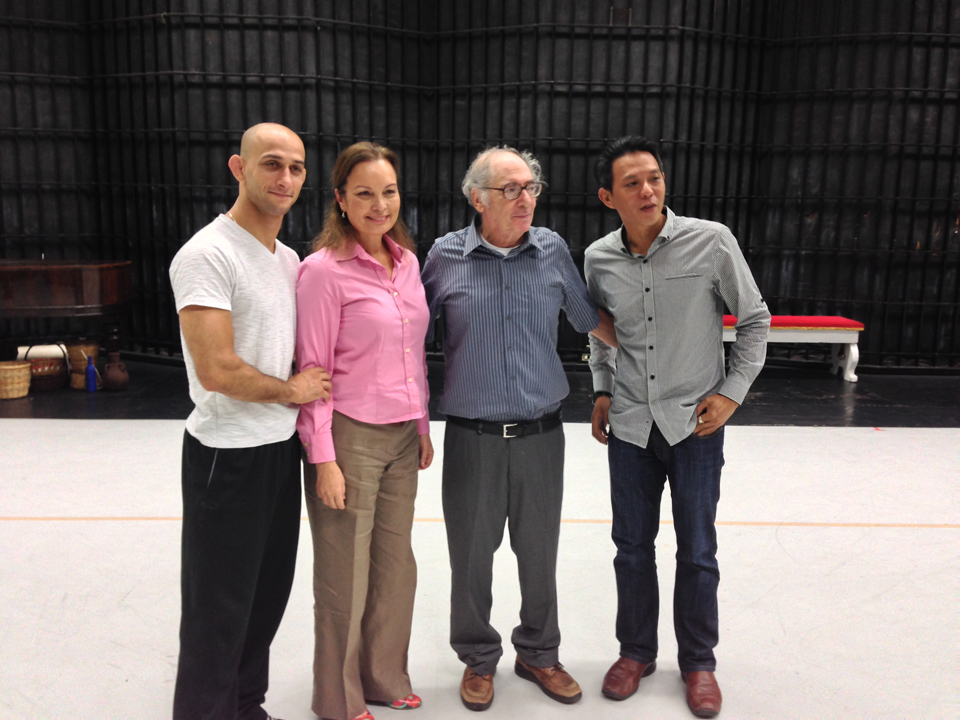Filtered By: Lifestyle
Lifestyle
George Birkadze tweaks ‘Romeo and Juliet,’ ‘Farandole’ for Ballet Philippines
Text and Photos by IBARRA C. MATEO

Choreographer George Birkadze on the far left.
With the grace of a gazelle, the intensity of a lion, and the looks and build of a Hollywood star, Ballet Philippines' guest choreographer George Birkadze rehearsed BP dancers with all the precise movements, clean body lines, and emotional nuances of the two of his works BP mounts next month: the “R/J” for Romeo and Juliet and the “Farandole.”
Born on Dec. 21, 1975 in Tbilisi, Georgia—then under the clutches of the USSR—Birkadze kicked off the early years of his dance studies at the National Academy of Dance of Tbilisi under the internationally revered Vakhtang Chabukiani, who is considered as one of the most influential male ballet dancers globally.
To see the world, you must dance
To see the world, you must dance
The brawny Birkadze dreamed of traveling around the world since his youth. When the then-USSR was at its political prime, the singular avenue for a USSR citizen to go abroad was to excel in the arts and become nationally celebrated. Every plie, releve, sauté, kick, turn, jump, and pirouette that Birkadze executed in the rehearsal halls and various theaters were anchored and hinged on this goal: to see the world.
And they all paid off eventually. In 1990, 15-year-old Birkadze was invited to join and study at the elite Bolshoi Theater in Moscow.
“I was blessed to have great, famous teachers in Moscow—even though I am not a Russian but a Georgian. I was born and I grew up in a small and not powerful country. Thus, I tried to be the best because I was always the last guy in the group, the guy who will not make it,” he said wistfully in an interview.
Life was not easy in Moscow for Birkadze, where he was bullied. The bullying forced him to study karate and judo side-by-side with ballet.
The compulsory two-year military service in the Soviet armed forces disrupted his dancing career. He served in the Soviet army’s special forces division, where he learned other forms of martial arts such as jiu-jitsu.
After completing his military service, Birkadze re-joined the Bolshoi Theater and subsequently moved to the Kremlin Ballet Theater. It was his stint in the exclusive Kremlin Ballet Theater which paved the way for his overseas travels and engagements in Portugal, France, Spain, and the US, where he would eventually settle down.
The political skirmishes and crises between Russia and his native Georgia prompted him to move initially to Western Europe. Brighter opportunities brought him to the US, where he now works for the Boston Ballet, the Sarasota Ballet, and the Rhode Island Ballet.

Teaching Ballet Philippines

Birkadze and some Ballet Philippines dancers during a rehearsal.
Teaching Ballet Philippines
“When I teach the Ballet Philippines dancers, I try to transmit the skills and expertise I’ve learned from my talented teachers. I think the Ballet Philippines officers and staff are doing an unbelievable job despite the local challenges,” Birkadze said during the interview.
“The level of skills and expertise of the Ballet Philippine dancers is very high. The dancers are technically very strong. Without any doubt, I am telling you the dancers move very well. The improvement and progress by the dancers during my first visit in 2013 and this time are simply amazing,” he added.
Birkadze was “connected” to BP by Boston native and balletomane Norman Turner, who is married to Filipina Annie Dupitas Turner.
Birkadze recalled being approached by Turner after a performance during one of the seasons of the Festival Ballet Providence on Rhode Island. Turner mentioned that he annually visits the Philippines and asked if Birkadze would be interested in teaching Filipino ballet dancers.
“Norman said there is a great ballet company in Philippines. He said I feel the energy of the great dancers and great officers. Would I like to go to the Philippines when he goes there with his wife?” Birkadze said.
Staging Balanchine pieces
Staging Balanchine pieces
In a separate interview, Turner said the BP dancers are “very young but technically very strong and very good.”
“While we may heap praises on a choreographer when we see dancers dance, a choreographer can only do or stage what the dancers are capable of doing. The BP dancers are capable of doing difficult works,” Turner said.
“A dancer wants to dance. They need great choreographers to challenge. I have suggested to Paul Morales the possibility of doing more George Balanchine ballet pieces. Balanchine is well known,” Turner added.
Paul Alexander Morales is the BP artistic director.
Turner said the BP audience and market may grow bigger if Balanchine is staged because of the Georgian choreographer’s popularity and “famous brand of ballet.”
“The audience may not come if they do not know the name of the choreographer or the name of the piece. In an ideal world, it should not be like this,” Turner said.
Birkadze’s neoclassical pieces “R/J” and “Farandole” will be mounted by BP on Sept. 26 and 27.
“R/J” condenses the ubiquitous Romeo and Juliet love story in a seven-minute pas de deux, which ends before the moment Juliet awakens from her drug-induced sleep.
Meanwhile, “Farandole” is a group dance set to music from George Bizet’s “Carmen” and showcases the dancers’athleticism and bravura, with a slight Spanish flavor.
Originally staged by the Sarasota Ballet, Birkadze said the “Farandole” to be performed by BP is “almost completely different, as it was customized to better showcase and accentuate the BP dancers’ strengths and skills.” — VC, GMA News
More Videos
Most Popular



